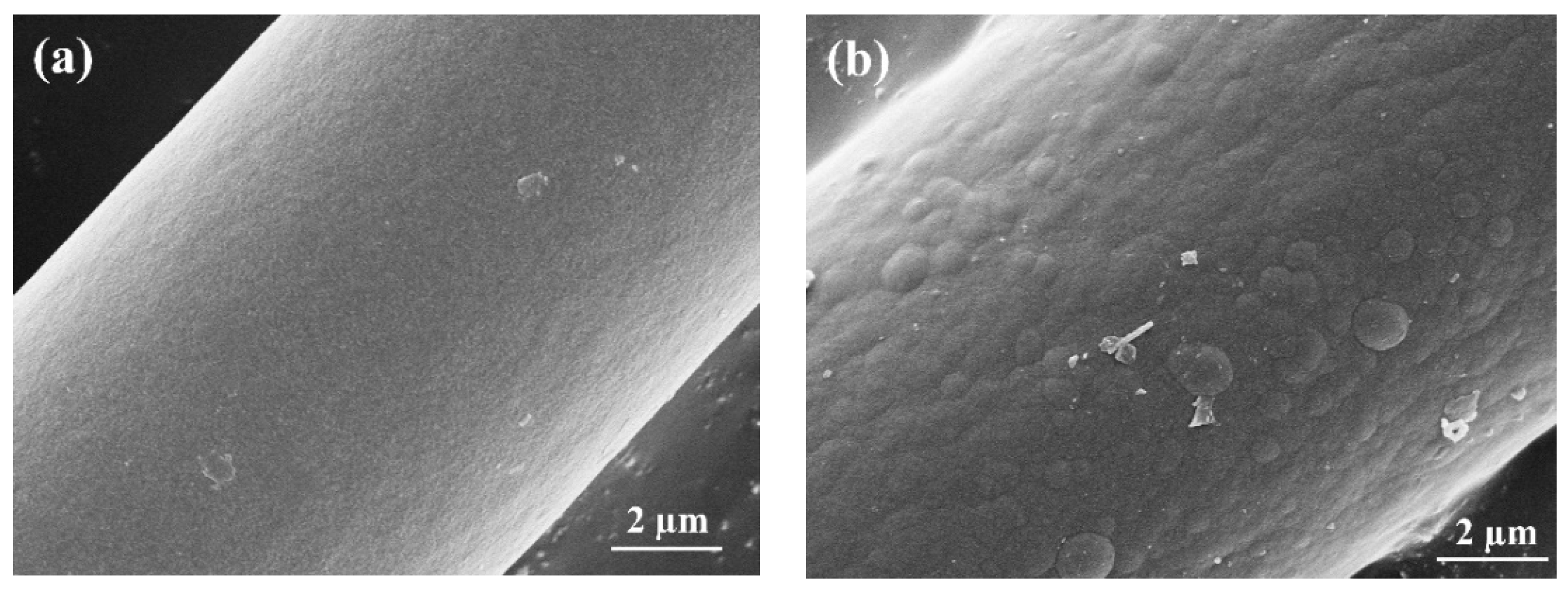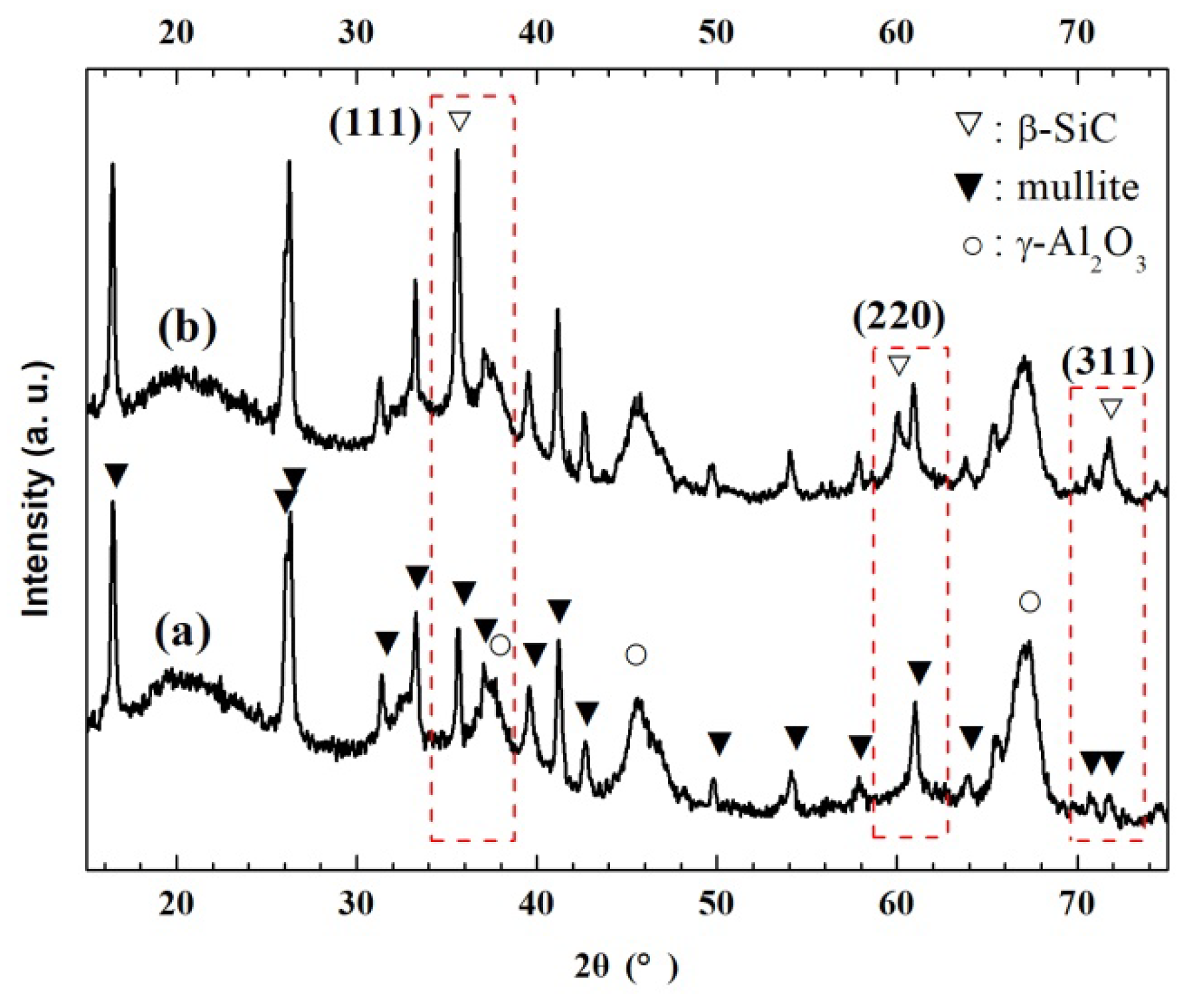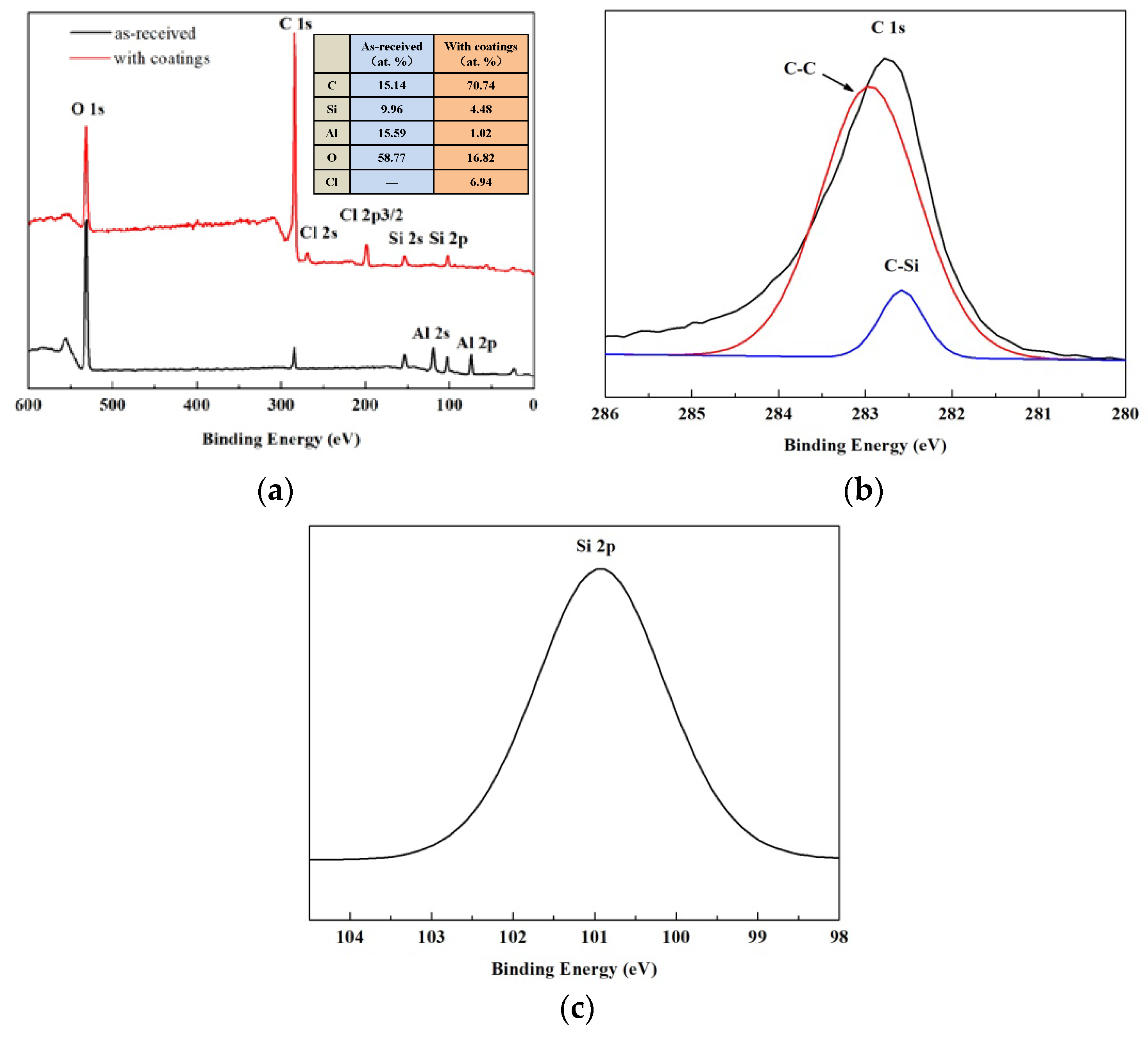Deposition Mechanism and Thickness Control of CVD SiC Coatings on NextelTM440 Fibers
Abstract
:1. Introduction
2. Experimental Procedure
2.1. Materials and Deposition of Coatings
2.2. Characterization
3. Results and Discussion
3.1. Characteristics of the CVD SiC Coatings
3.2. Thickness Control of the CVD SiC Coatings
3.3. Deposition Mechanism Research
4. Conclusions
- Carbon-rich SiC coatings were synthesized on NextelTM440 fibers by CVD. Some traces of bulges were observed on the coating surface.
- CVD SiC coatings with different thickness were obtained by varying the deposition time. As the deposition time increased from 1 to 4 h, the coating thickness increased from 143.5 nm to 1.5 µm accordingly. An empirical formula was put forward to calculate the coating thickness, and the calculated thickness was quite coincident with the measured one.
- The deposition mechanism of the coatings was discussed. Spherical SiC particles were formed at a high rate on alumina micro-grains at the fiber surface, and the coatings became looser with increasing thickness due to the reduction of the adhesion force on the coating surface.
Author Contributions
Funding
Conflicts of Interest
References
- Naslain, R. Design, preparation and properties of non-oxide CMCs for application in engines and nuclear reactors: An overview. Compos. Sci. Technol. 2004, 64, 155–170. [Google Scholar] [CrossRef]
- Koyanagi, T.; Katoh, Y.; Nozawa, T.; Snead, L.-L.; Kondo, S.; Henager, C.-H., Jr.; Ferraris, M.; Hinoki, T.; Huang, Q. Recent progress in the development of SiC composites for nuclear fusion applications. J. Nucl. Mater. 2018, 511, 544–555. [Google Scholar] [CrossRef]
- Arai, Y.; Inoue, R.; Goto, K.; Kogo, Y. Carbon fiber reinforced ultra-high temperature ceramic matrix composites: A review. Ceram. Int. 2019, 45, 14481–14489. [Google Scholar] [CrossRef]
- Shen, Z.-Z.; Chen, J.-H.; Li, B.; Li, G.-Q.; Zhang, Z.-J.; Hou, X.-M. Recent progress in SiC nanowires as electromagnetic microwaves absorbing materials. J. Alloy. Comp. 2020, 815, 152388. [Google Scholar] [CrossRef]
- Chawla, K.-K. Interface engineering in mullite fiber/mullite matrix composites. J. Eur. Ceram. Soc. 2008, 28, 447–453. [Google Scholar] [CrossRef]
- Zhang, M.-Y.; Li, K.-Z.; Shi, X.-H.; Tan, W.-L. Effects of SiC interphase on the mechanical and ablation properties of C/C-ZrC-ZrB2-SiC composites prepared by precursor infiltration and pyrolysis. Mater. Des. 2017, 122, 322–329. [Google Scholar] [CrossRef]
- Zhou, W.; Long, L.; Li, Y. Mechanical and electromagnetic wave absorption properties of Cf-Si3N4 ceramics with PyC/SiC interphases. J. Mater. Sci. Technol. 2019, 35, 2809–2813. [Google Scholar] [CrossRef]
- Tian, H.; Liu, H.-T.; Cheng, H.-F. A high-temperature radar absorbing structure: Design, fabrication, and characterization. Compos. Sci. Technol. 2014, 90, 202–208. [Google Scholar] [CrossRef]
- Wang, Y.; Cheng, H.-F.; Wang, J. Mechanical and Dielectric Properties of Mullite Fiber-Reinforced Mullite Matrix Composites with Single Layer CVD SiC Interphases. Int. J. Appl. Ceram. Technol. 2015, 12, 500–509. [Google Scholar] [CrossRef]
- Liu, H.-T.; Cheng, H.-F.; Wang, J.; Tang, G.-P. Effects of the single layer CVD SiC interphases on the mechanical properties of the SiCf/SiC composites fabricated by PIP process. Ceram. Int. 2010, 36, 2033–2037. [Google Scholar] [CrossRef]
- Xiang, Y.; Li, W.; Wang, S.; Chen, Z.-H. Effects of the single layer CVD SiC interphases on the mechanical properties of the C/SiC composites fabricated by PIP process. Mater. Sci. Eng. A 2012, 558, 451–455. [Google Scholar]
- Wang, Y.; Cheng, H.-F.; Wang, J. Effects of the single layer CVD SiC interphases on mechanical properties of mullite fiber-reinforced mullite matrix composites fabricated via a sol–gel process. Ceram. Int. 2014, 40, 4707–4715. [Google Scholar] [CrossRef]
- Yu, H.-J.; Zhou, X.-G.; Zhang, W.; Peng, H.-X.; Zhang, C.-R. Mechanical behavior of SiCf/SiC composites with alternating PyC/SiC multilayer interphases. Mater. Des. 2013, 44, 320–324. [Google Scholar] [CrossRef]
- Chen, S.-A.; Zhang, Y.-D.; Zhang, C.-R.; Zhao, D.; Hu, H.-F.; Zhang, Z.-B. Effects of SiC interphase by chemical vapor deposition on the properties of C/ZrC composite prepared via precursor infiltration and pyrolysis route. Mater. Des. 2013, 46, 497–502. [Google Scholar] [CrossRef]
- 3MTM NextelTM Ceramic Fibers and Textiles Technical Reference Guide. 2018. Available online: http://www.3M.com/ceramics (accessed on 9 February 2019).
- Hay, R.-S.; Welch, J.-R.; Cinibulk, M.-K. TEM specimen preparation and characterization of ceramic coatings on fiber tows. Thin Solid Films 1997, 308–309, 389–392. [Google Scholar] [CrossRef]
- Youm, M.-R.; Yun, S.; Choi, S.-C.; Park, S.-W. Synthesis of β-SiC powders by the carbothermal reduction of porous SiO2–C hybrid precursors with controlled surface area. Ceram. Int. 2020, 46, 4870–4877. [Google Scholar] [CrossRef]
- Jiamprasertboon, A.; Dixon, S.-C.; Sathasivam, S.; Powell, M.-J.; Lu, Y.; Siritanon, T.; Carmalt, C.-J. Low-Cost One-Step Fabrication of Highly Conductive ZnO:Cl Transparent Thin Films with Tunable Photocatalytic Properties via Aerosol-Assisted Chemical Vapor Deposition. ACS Appl. Electron. Mater. 2019, 1, 1408–1417. [Google Scholar] [CrossRef] [Green Version]
- Zhang, C.; Qu, L.; Yuan, W.-J. Effects of Si/C ratio on the phase composition of Si-C-N powders synthesized by carbonitriding. Materials 2020, 13, 346. [Google Scholar] [CrossRef] [Green Version]
- Dietrich, D.; Martin, P.-W.; Nestler, K.; Stöckel, S.; Weise, K.; Marx, G. Transmission electron microscopic investigations on SiC- and BN-coated carbon fibres. J. Mater. Sci. 1996, 31, 5979–5984. [Google Scholar] [CrossRef]
- Górka, J.; Czupryński, A.; Żuk, M. Properties and structure of deposited nanocrystalline coatings in relation to selected construction materials resistant to abrasive wear. Materials 2018, 11, 1184. [Google Scholar] [CrossRef] [Green Version]
- Czupryński, A. Flame spraying of aluminum coatings reinforced with particles of carbonaceous materials as an alternative for laser cladding technologies. Materials 2019, 12, 3467. [Google Scholar] [CrossRef] [PubMed] [Green Version]
- Zheng, Y.; Wang, S.-B. Synthesis of boron nitride coatings on quartz fibers: Thickness control and mechanism research. Appl. Surf. Sci. 2011, 257, 10752–10757. [Google Scholar] [CrossRef]
- Reznik, B.; Gerthsen, D.; Zhang, W.-G.; Hüttinger, K.-J. Microstructure of SiC deposited from methyltrichlorosilane. J. Eur. Ceram. Soc. 2003, 23, 1499–1508. [Google Scholar] [CrossRef]
- Zhang, W.-G.; Hüttinger, K.-J. CVD of SiC from Methyltrichlorosilane. Part II: Composition of the Gas Phase and the Deposit. Chem. Vap. Depos. 2001, 7, 173–181. [Google Scholar] [CrossRef]
- Long, Y.; Javed, A.; Chen, Z.-K.; Xiong, X.; Xiao, P. Deposition rate, texture, and mechanical properties of SiC coatings produced by chemical vapor deposition at different temperatures. Int. J. Appl. Ceram. Technol. 2013, 10, 11–19. [Google Scholar] [CrossRef]
- Zhou, W.; Long, Y. Mechanical properties of CVD-SiC coatings with Si impurity. Ceram. Int. 2018, 44, 21730–21733. [Google Scholar] [CrossRef]









| Deposition Time (h) | 1 | 2 | 4 |
|---|---|---|---|
| Measured thickness (nm) | 143.5 ± 14.2 | 364.2 ± 12.5 | 1542.2 ± 17.0 |
| Theoretical thickness (nm) | 181.5 | 499.3 | 2001.2 |
© 2020 by the authors. Licensee MDPI, Basel, Switzerland. This article is an open access article distributed under the terms and conditions of the Creative Commons Attribution (CC BY) license (http://creativecommons.org/licenses/by/4.0/).
Share and Cite
Wang, Y.; Sun, J.; Sheng, B.; Cheng, H. Deposition Mechanism and Thickness Control of CVD SiC Coatings on NextelTM440 Fibers. Coatings 2020, 10, 408. https://doi.org/10.3390/coatings10040408
Wang Y, Sun J, Sheng B, Cheng H. Deposition Mechanism and Thickness Control of CVD SiC Coatings on NextelTM440 Fibers. Coatings. 2020; 10(4):408. https://doi.org/10.3390/coatings10040408
Chicago/Turabian StyleWang, Yi, Jian Sun, Bing Sheng, and Haifeng Cheng. 2020. "Deposition Mechanism and Thickness Control of CVD SiC Coatings on NextelTM440 Fibers" Coatings 10, no. 4: 408. https://doi.org/10.3390/coatings10040408





